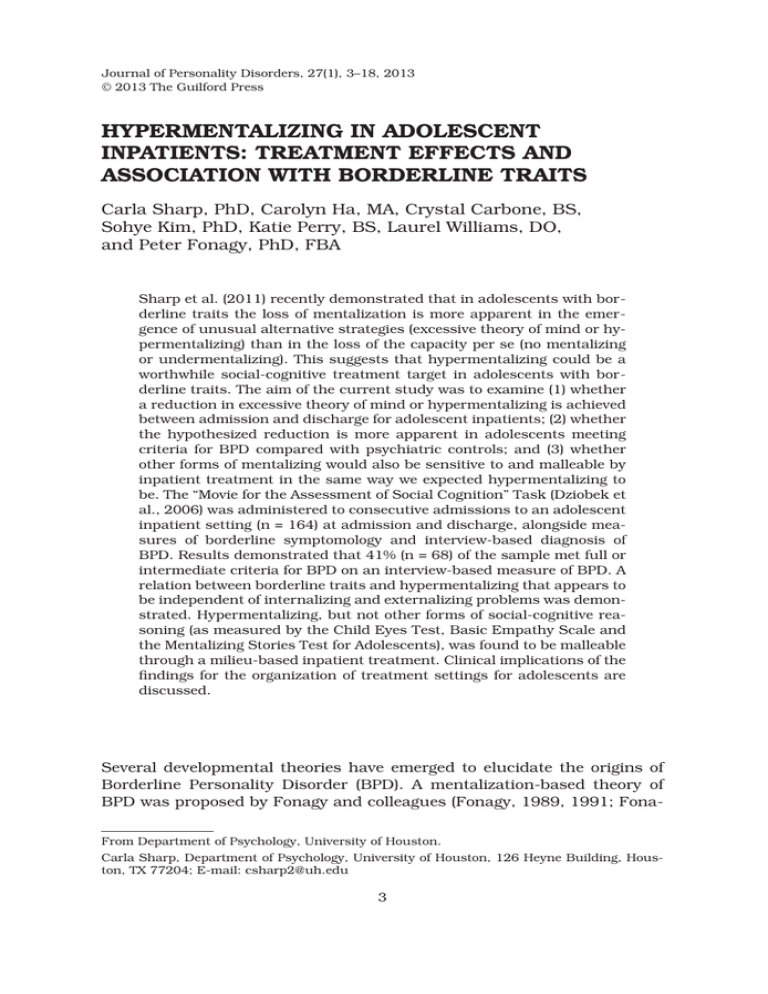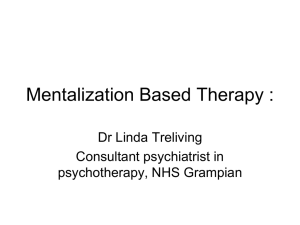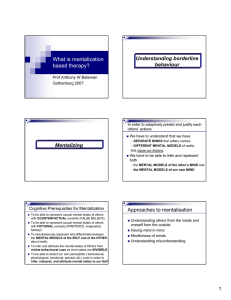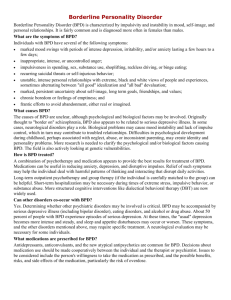hyPermenTalizing in adolescenT inPaTienTs: TreaTmenT effecTs and associaTion wiTh borderline TraiTs
advertisement

Journal of Personality Disorders, 27(1), 3–18, 2013 © 2013 The Guilford Press Hypermentalizing in adolescent inpatients: Treatment effects and association with borderline traits Carla Sharp, PhD, Carolyn Ha, MA, Crystal Carbone, BS, Sohye Kim, PhD, Katie Perry, BS, Laurel Williams, DO, and Peter Fonagy, PhD, FBA Sharp et al. (2011) recently demonstrated that in adolescents with borderline traits the loss of mentalization is more apparent in the emergence of unusual alternative strategies (excessive theory of mind or hypermentalizing) than in the loss of the capacity per se (no mentalizing or undermentalizing). This suggests that hypermentalizing could be a worthwhile social-cognitive treatment target in adolescents with borderline traits. The aim of the current study was to examine (1) whether a reduction in excessive theory of mind or hypermentalizing is achieved between admission and discharge for adolescent inpatients; (2) whether the hypothesized reduction is more apparent in adolescents meeting criteria for BPD compared with psychiatric controls; and (3) whether other forms of mentalizing would also be sensitive to and malleable by inpatient treatment in the same way we expected hypermentalizing to be. The “Movie for the Assessment of Social Cognition” Task (Dziobek et al., 2006) was administered to consecutive admissions to an adolescent inpatient setting (n = 164) at admission and discharge, alongside measures of borderline symptomology and interview-based diagnosis of BPD. Results demonstrated that 41% (n = 68) of the sample met full or intermediate criteria for BPD on an interview-based measure of BPD. A relation between borderline traits and hypermentalizing that appears to be independent of internalizing and externalizing problems was demonstrated. Hypermentalizing, but not other forms of social-cognitive reasoning (as measured by the Child Eyes Test, Basic Empathy Scale and the Mentalizing Stories Test for Adolescents), was found to be malleable through a milieu-based inpatient treatment. Clinical implications of the findings for the organization of treatment settings for adolescents are discussed. Several developmental theories have emerged to elucidate the origins of Borderline Personality Disorder (BPD). A mentalization-based theory of BPD was proposed by Fonagy and colleagues (Fonagy, 1989, 1991; FonaFrom Department of Psychology, University of Houston. Carla Sharp, Department of Psychology, University of Houston, 126 Heyne Building, Houston, TX 77204; E-mail: csharp2@uh.edu 3 4 Sharp et al. gy, Gergely, Jurist, & Target, 2002; Fonagy & Luyten, 2009; Sharp & Fonagy, 2008b) which posits that a vulnerability to failures or misinterpretations of actions in terms of underpinning mental states may account for core features of BPD. In particular, Fonagy and colleagues have argued that as the child’s attachment relationships have an important role to play in the acquisition of social cognitive capacities (Sharp & Fonagy, 2008a), disruptions of early attachment experiences can derail social-cognitive (metalizing) development (see Fonagy & Luyten [2009] for a comprehensive description of this developmental framework for the development of BPD). Over the past 5–10 years an impressive body of empirical evidence has been accumulated in support of anomalies of various components of mentalizing in adults with BPD. The downward extension of this research has begun, and Sharp et al. (2011) recently used the Movie Assessment of Social Cognition (MASC; Dziobek et al., 2006) in adolescents with borderline traits to demonstrate that an anomaly of mentalization is more apparent in the emergence of unusual alternative strategies (hypermentalizing or excessive theory of mind) than in the loss of the capacity per se (no mentalizing or less mentalizing). Hypermentalizing, also referred to as excessive theory of mind by Dziobek et al. (2006) can be defined as a socialcognitive process that involves making assumptions about other people’s mental states that go so far beyond observable data that the average observer will struggle to see how they are justified. As such, it involves overattribution of mental states to others and their likely misinterpretation. For example, person A invites person B to dinner, but B replies hurriedly that she is unavailable because she has a prior engagement. A then assumes that B does not want to spend time with her because of a minor incident of misunderstanding that she recalls from several years ago, and generates a complex narrative about B’s overreaction and her apparent inability to forgive. We refer to this as hypermentalizing because A was using mental states to explain B’s actions, but overattributed mental states that were unlikely to be real. This process has also been termed “pseudomentalizing” in prior literature because it looks like mentalizing but it lacks some of the essential features of accurate mentalizing (Allen, Fonagy, & Bateman, 2008). Given the Sharp et al. (2011) findings of an association between hypermentalizing and borderline traits in adolescents, this maladaptive social-cognitive process could be a worthwhile treatment target when working with adolescents with borderline traits. However, mentalizing is a heterogeneous and multidimensional construct (Fonagy & Luyten, 2009). If hypermentalizing is the key anomaly in the mentalization difficulties of BPD in youths, we would anticipate abnormalities and treatment-associated changes to be related to this dimension of mentalizing and restricted to those with BPD diagnoses, rather than simply to the severity and normalization of psychiatric disorder. In this study, we considered several other forms of mentalizing in addition to hypermentalizing, following Lieberman’s (2007) differentiation of aspects Hypermentalizing in adolescent inpatients5 of social cognition into explicit-controlled versus implicit-automatic; mentalizing related to the self versus related to the other; and mentalizing based on external indicators versus internal features computed on the basis of contextual or historical information. Evidence has been gathered for the specific association of BPD with failures of internal, explicitcontrolled mentalizing related both to self and other (Fonagy & Luyten, 2009), but thus far, no study has examined whether change in other anomalous forms of mentalizing occurs between admission and discharge in adolescent or adult inpatients or outpatients. In classifying different mentalizing tasks after Lieberman, we acknowledge that most tasks currently used to assess mentalizing are complex and thus engage both ends of polarities such as controlled versus automatic mentalizing. However, certain tasks appear to require more explicitcontrolled mentalizing, while others call predominantly for implicitautomatic mentalizing. For instance, we suggest that while the MASC is heavily dependent on contextual cues, requiring the participant to infer mental states from indicators that are not physically apparent, the Child’s Eye Task (CET; Baron-Cohen, Wheelwright, Hill, Raste, & Plumb, 2001) calls on an individual’s capacity to read the mental states of others from external cues, a decontextualized display of just the eye region of the face. It therefore taps explicit-controlled mentalizing and is based on external features of others. The MASC also asks for reflection and thus also draws on explicit-controlled mentalizing (as opposed to, for instance, highly implicit tasks that are primarily behavioral and capture, for example, an infant’s surprise when expectations based on putative mental states of the agent were disconfirmed; Kovacs, Teglas, & Endress, 2010). Another relatively implicit task of mentalizing that provides slightly less context than the MASC is the Mentalizing Stories Test for Adolescents (Vrouva & Fonagy, 2009). The MSTA requires participants to choose one of three interpretations in relation to an adolescent’s behavior from a list, which may be nonmentalizing, appropriately mentalizing, or inappropriately mentalizing (pseudomentalizing) beyond the data available in the story stem. Finally, we also included a measure of empathy. Empathy is traditionally dissociated from mentalizing in the literature, but it may be conceptualized as affective mentalizing within Baron-Cohen, Golan, Chakrabarti, and Belmonte’s (2008) approach to theory of mind. Within this approach, empathy is seen as requiring reflection on the mental interior of the other as the feeling of feeling (Fonagy & Luyten, 2009). Against this background, the aims of the current study were to examine (1) whether a reduction in excessive theory of mind or hypermentalizing is achieved between admission and discharge for adolescent inpatients; (2) whether the hypothesized reduction is more apparent in adolescents meeting criteria for BPD than in psychiatric controls and in line with changes in the severity of BPD symptoms, as would be predicted by the model; and (3) whether other forms of mentalizing problems can be observed in adolescents with BPD traits and might also be malleable with 6 Sharp et al. inpatient treatment. We wished to demonstrate that the forms of mentalizing most sensitive to and malleable by treatment in those with borderline traits tend to be implicit, automatic, and concerned with the interior mental world of the other rather than the external features of the other. Methods Participants All consecutive admissions (N = 257) to the adolescent treatment program of a private tertiary care inpatient treatment facility were approached to participate in the study. Inclusion criteria were age between 12 and 17, proficiency in English, and admission to the unit. Forty participants were excluded from the final analyses due to declining (n = 23) or revoking (n = 2) consent, discharge prior to the completion of research assessments (n = 2), or exclusion criteria, which included active psychosis (n = 5), IQ < 70, diagnosis of autism spectrum disorder, or primary language not being English (n = 8). All adolescents were admitted voluntarily. After exclusions, 217 inpatients had admission data available. Of these, 53 (24%) could not complete discharge assessments, chiefly because of sudden, unexpected decisions to leave the facility initiated by the patient, her or his parents, or clinical staff. Therefore, our final sample comprised 164 adolescents (62 girls and 49 boys; mean age = 15.5; SD = 1.44). Of the sample, 64.5% scored above the clinical cut-off (T-score of 65) for internalizing disorders and 56.5% for externalizing disorders on the Youth Self Report (YSR; Achenbach & Rescorla, 2001), while 41% (n = 68) of the sample met full or intermediate criteria for BPD in the Childhood In­ terview for DSM-IV Borderline Personality Disorder (CI-BPD; Zanarini, 2003). Measures Mentalizing. Hypermentalizing at admission and discharge was assessed through the MASC (Dziobek et al., 2006). This is a computerized test for the assessment of implicit theory of mind or mentalizing abilities that approximates the demands of everyday life. Examples of test stimuli are provided in the Appendix. Participants are asked to watch a 15-minute film about four characters getting together for a dinner party. During administration of the task, the film is stopped during the plot and questions referring to the characters’ mental states (feelings, thoughts, and intentions) are asked (e.g., What is Betty feeling?, What is Cliff thinking?). Participants are provided with four response options: (1) a hypermentalizing response, (2) an undermentalizing response, (3) a nonmentalizing response, and (4) an accurate mentalizing response. To derive a summary score for each of the subscales, 1 point per response is added, so that, for instance, a participant who chose mostly hypermentalizing response options would have a high hypermentalizing score. The MASC is a reliable instrument Hypermentalizing in adolescent inpatients7 that has proven sensitive in detecting subtle mindreading difficulties in adults of normal IQ (Dziobek et al., 2006). Explicit-Controlled and External Mentalizing. This was assessed with the CET Baron-Cohen et al., 2001), which is based on a deficit approach to theory of mind or social cognition (Sharp & Fonagy, 2008b). The test includes 28 black-and-white photographs of the eye region; the participant is asked to pick one of four words that best describes what the person in the photo is thinking or feeling. Three of the four words are foil mental state terms and the fourth is deemed correct. For instance, the first eye region depicted provided the response options “playful, comforting, irritated, bored.” Given the complex mental states that are inferred from the eye region of the face, the task is considered an advanced test of theory of mind (Baron-Cohen et al., 2001). The position of the correct answer is randomized for each item. Correct answers are scored as 1 and then summed to produce a total correct score. Implicit Mentalizing and Pseudomentalizing. These were assessed with the MSTA (Vrouva & Fonagy, 2009). The MSTA is a 21-item self-report measure assessing both mentalizing and pseudomentalizing. Each item provides a vignette and instructions to choose one of three possible answers. Responses are summed to provide a total score for mentalizing, with higher scores suggesting adequate mentalizing. The same items are also scored for pseudomentalizing, with higher scores indicating a greater use of the strategy. Good psychometric properties have been reported with a Cronbach’s alpha of .76 (Vrouva, Target, & Ensink, 2012). Empathy. This was assessed with the Basic Empathy Scale (BES; Jolliffe & Farrington, 2006), which is a valid multidimensional measure of empathy. While experimental measures of empathy are superior to selfreport measures, self-report measures still provide a useful index of empathic ability. All responses are summed for a total score; high scores reflect high empathy. Good internal consistency was found for this sample (α = .86). Diagnosis of BPD. Diagnosis of BPD was determined by the CI-BPD which is a semistructured interview that assesses DSM-IV BPD in children and adolescents (Zanarini, 2003). After asking a series of corresponding questions, the interviewer rates each DSM-based criterion on a score of 0 (absent), 1 (probably present), or 2 (definitely present). The CI-BPD has excellent psychometric properties (Zanarini, 2003; Sharp, Ha, Michonski, Venta, & Carbonne, 2012) and demonstrated significant, albeit moderate, agreement to clinician diagnosis at time of discharge in the current sample (Kappa = .47; p < .001). Internal consistency was good with a Cronbach’s alpha of .82. Dimensional Measure of BPD Traits. The Borderline Personality Features Scale for Children (BPFSC; Crick, Murray-Close, & Woods, 2005) is a 24item questionnaire measure that assesses borderline personality features in children and adolescents ages 9 and older. Responses are scored on a five-point Likert scale, ranging from 1 (not at all true) to 5 (always true) 8 Sharp et al. with higher total scores indicating greater levels of borderline personality features. Criterion validity has been reported (Chang, Sharp, & Ha, 2011) and in the present sample, internal consistency of this measure was good, with a Cronbach’s alpha of .88. Externalizing and Internalizing Problems. Dimensional indices of externalizing and internalizing problems were obtained by administering the YSR (Achenbach & Rescorla, 2001), which is an established evidencebased assessment instrument (Holmbeck et al., 2008). Categorical indices of internalizing and externalizing problems were obtained by administering the Diagnostic Interview Schedule for Children (DISC; Shaffer, Fisher, Lucas, Dulcan, & Schwab Stone, 2000). Data Analysis. Attrition analyses were conducted through the use of independent sample t-tests comparing patients for whom admission and discharge data were available and those for whom only admission data were available. Bivariate relations between hypermentalizing, BPD, other psychopathology, and demographic variables were examined through ttests, chi-square analyses, and correlational analyses. Repeated measures ANOVA was used to examine change scores in hypermentalizing (and other forms of social-cognitive function) as a function of BPD categorical diagnostic status (CI-BPD diagnosis). To examine whether the expected reduction in hypermentalizing was associated with change in BPD symptoms between admission and discharge, a change score for hypermentalizing was calculated by subtracting discharge from admission scores. Similarly, a change score for borderline symptoms (BPFSC) was calculated. A Pearson correlation was used to determine the association between the change scores. Results Attrition analyses We conducted independent sample t-tests for continuous variables (mentalizing, age, psychopathology at baseline) and chi-square tests for categorical variables (CI-BPD status and sex) between those for whom discharge data existed (n = 164) and those for whom discharge data were not obtained (n = 53) to determine whether any systematic differences existed that could bias findings. Results showed no significant differences between completers and non-completers in age (t = –1.41, df = 215, p = .16), YSR externalizing problems (t = –1.46, df = 212, p = .15), empathy (t = .907, df = 215, p = .37), baseline MASC hypermentalizing (t = –.215, df = 213, p = .83), MSTA mentalizing (t = –.333, df = 162, p = .74) and MSTA pseudomentalizing (t = .433, df = 162, p = .665). Furthermore, no significant differences were found in sex (χ2 = .787, df = 1, p = .38) or BPD diagnosis (χ2 = .070, df = 1, p = .79). However, marginally significant differences were found for YSR internalizing problems (t = –2.02, df = 212, p = Hypermentalizing in adolescent inpatients9 .045), with completers (M = 63.83, SD = 12.48) having higher internalizing problems scores than noncompleters (M = 59.62, SD = 14.83). Significant differences were also found between completers and noncompleters in the CET (t = 2.05, df = 213, p = .04), with completers (M = 19.82, SD = 2.57) having significantly lower mentalizing scores than noncompleters (M = 20.69, SD = 3.02). Bivariate Relations Between Hypermentalizing, BPD, Other Psychopathology, and Demographic Variables Nearly 41% (n = 68) of the sample met full or intermediate criteria for BPD. As shown in Table 1, independent sample t-tests showed significant differences between BPD versus non-BPD participants for hypermentalizing at admission, but not at discharge. No difference was found between BPD and non-BPD groups for age. However, significant differences were found for YSR internalizing problems and externalizing problems. Chi-square analyses revealed a relation between sex and BPD status. Independent sample t-tests revealed no significant differences for those with CDISC mood disorders versus those without mood disorders for hypermentalizing at admission or discharge; for CDISC anxiety disorders for hypermentalizing at admission and discharge; and for CDISC externalizing disorders for hypermentalizing at admission and discharge. These findings suggest that the tendency to hypermentalize was specific to BPD pathology rather than pathology of mood, anxiety, or conduct. The results of bivariate correlations are summarized in Table 2. Hypermentalizing at admission was positively correlated with hypermentalizing at discharge and severity of borderline symptoms at admission, and negatively correlated with age. The association between hypermentalizing at discharge and borderline symptoms at admission was weaker, and the correlation between hypermentalizing at discharge and borderline symptoms at discharge was negligible. Hypermentalizing at admission and discharge did not correlate with either internalizing or externalizing problems, again confirming specificity for the relation between hypermentalizing and BPD. Reduction in Hypermentalizing Between Admission and Discharge for BPD Versus Non-BPD Groups The results of a repeated measures ANOVA with hypermentalizing at admission and discharge as within-subjects variables and BPD status as between-subjects variable demonstrated a main effect for hypermentalizing (F = 76.11; p < .001; partial eta squared = .32) as well as an interaction effect for BPD and hypermentalizing (F = 5.30; p = .02; partial eta squared = .03; for means of hypermentalizing at admission and discharge, see Table 1). These findings suggest that, while hypermentalizing was sig- 10 Age in months Sex Hypermentalizing admission Hypermentalizing discharge YSR Internalizing problems YSR Externalizing problems CDISC any mood disorder CDISC any anxiety disorder CDISC any externalizing 192.08 (16.76) 61.6% female 7.94 (2.97) 5.79 (2.88) 63.83 (12.48) 61.93 (11.55) 60.9% positive 77.6% positive 44.6% positive N = 164 M (SD) or % 191.14 (18.00) 67.6% female 8.76 (4.36) 5.93 (3.08) 69.16 (11.52) 67.38 (11.63) 67.7% positive 76.6% positive 57.6% positive n = 68 M (SD) or % 193.14 (15.45) 56.8% female 7.37 (3.59) 5.72 (2.73) 60.27 (11.44) 58.09 (9.80) 56.0% positive 76.1% positive 35.2% positive n = 96 M (SD) or % t = .75, df = 163, p = .45 χ² = 9.99, df = 1, p = .002 t = –2.23, df = 163, p = .02 t = –.45, df = 163, p = .64 t = –4.85, df = 163, p < .001 t = –5.49, df = 163, p = < .001 χ² = 2.16, df = 1, p = .14 χ² = .05, df = 1, p = .82 χ² = 7.77, df = 1, p = .005 Differences between BPD vs. non-BPD groups Table 1. Descriptive Statistics and Bivariate Relations for Hypermentalizing, BPD, Other Psychopathology, and Demographic Variables Full sample BPD Non-BPD Hypermentalizing in adolescent inpatients11 Table 2. Bivariate Correlations Between Main Study Variables. 1. 2. 3. 4. 5. 6. 7. 8. 1. HyperMZ adm 2. HyperMZ dis 3. CET 4. BES 5. MZ 6. PseudoMZ 7. Age 8. YSR Int 9. YSR Ext 10. BPFSC — .58** −.08 −.09 −.32** .33** −.20* .12 .14 .29** — −.08 −.07 −.34** .36** −.12 .06 −.02 .14 — .06 — .20* .01 −.19* .009 −.04 −.01 .01 .19** −.04 −.04 .05 .18** — –.98** .17* .02 −.05 -.05 9. — −.18* — −.007 .08 — . .07 .06 .35** — .08 −.05 .55** .56** 10. — Note. adm = Admission; dis = discharge; CET = Children’s Eye Task; BES = Basic Empathy Scale; MZ = mentalizing (MSTA); PseudoMZ = pseudomentalizing (MSTA); Int = Internalizing subscale; Ext = Externalizing subscale. *p < .01; **p < .001. nificantly reduced between admission and discharge for both BPD and non-BPD groups, the reduction was more pronounced for the BPD group. The correlation between the hypermentalizing change score and the borderline symptom change score was negative and highly significant (r = –.25; p = .005), suggesting that change in hypermentalizing was associated with change in borderline symptoms. Improvement in Other Forms of Mentalizing Between Admission and Discharge for BPD Versus Non-BPD Groups Having demonstrated a reduction in hypermentalizing between admission and discharge of all inpatients associated with a reduction of borderline symptoms and specific to patients with marked borderline traits, we next investigated whether similar changes could be demonstrated for other forms of mentalization. Table 3 summarizes the results of repeated measures ANOVA with various forms of mentalizing at admission and discharge as within-subjects variables and BPD status as between-subjects variable. As Table 3 shows, there were no significant improvements in explicitcontrolled mentalizing (CET scores), empathy (BES scores), or mentalizing capacity (MSTA mentalizing scores) between admission and discharge. However, a significant reduction for the sample as a whole was observed for the pseudomentalizing scores as measured by the MSTA, although the interaction effect for pseudomentalizing between time and BPD status was not significant. Moreover, inspection of the correlational matrix in Table 2 reveals a significant positive relation between hypermentalizing and pseudomentalizing (as measured by the MSTA) and a significant negative relation between hypermentalizing and mentalizing capacity (as measured by the MSTA). This suggests that, although statistically not detectable, pseudomentalizing on the MSTA may be tapping a similar domain of social cognition as hypermentalizing on the MASC. 12 73.14 (10.92) 116.17 (18.48) 52.64 (19.03) BES MZ PseudoMZ Discharge 49.97 (18.64) 118.56 (18.77) 73.69 (8.75) 20.22 (3.48) Admission 52.39 (18.80) 116.41 (18.07) 73.79 (11.23) 19.94 (2.80) Discharge 47.82 (18.79) 120.14 (18.90) 74.49 (10.09) 20.06 (3.48) Admission 52.79 (19.26) 116.02 (18.80) 72.71 (10.74) 20.08 (2.63) Discharge 51.40 (18.55) 117.51 (18.76) 73.11 (7.65) 20.34 (3.16) Multivariate tests CET: F = 1.50; p = .22 CET*BPD: F = 1.82; p = .17 BES: F = 1.20; p = .27 BES*BPD: F = .66; p = .41 MZ: F = 2.73; p = .10 MZ*BPD: F = .55; p = .45 PseudoMZ: F = 429.38; p < .001 PseudoMZ*BPD: F = .31; p = .57 Note. CET = Children’s Eye Task (explicit-controlled, external-other mentalizing); BES = Basic Empathy Scale (empathy); MZ = implicit-controlled, but internal-other mentalizing (as measured by the MSTA); PseudoMZ = pseudomentalizing (as measured by the MSTA 20.02 (2.69) CET Admission Table 3. Results of a Repeated Measures ANOVA with Mentalizing Variables as Between-Subjects Variables and CI-BPD Diagnosis as Between-Subjects Variable. Full sample BPD Non-BPD Hypermentalizing in adolescent inpatients13 Discussion Consistent with a prior study in adolescents with borderline traits (Sharp et al., 2011), the first major finding of the current study is a specific relation between borderline traits and symptoms on the one hand and hypermentalizing on the other that appears to be independent of internalizing and externalizing problems and most other anomalies of mentalizing. The second major finding of this study is that the tendency to hypermentalize was malleable by milieu-based inpatient treatment. In this structured treatment, the emphasis is placed on forming close relationships with mental health workers who provide structure and discipline, help in negotiating tasks of daily living, and extensive individual attention in dealing with emotional and behavioral problems as they arise in the course of the day. Other major components include specialized groups focusing on living skills, gender and sexuality, emotion regulation and, most importantly for the current study, increasing mentalizing skills. Thus, the theoretical framework within which this work is conducted is interpersonal-psychodynamic, although cognitive-behavioral, family systems, and psychoeducational approaches are incorporated into the treatment approach (Sharp et al., 2009). Hypermentalizing was found to be malleable with this protocol of treatment, while other, more explicit-controlled and external indicator-focused forms of mentalizing (as measured by the CET and BES) were not similarly responsive to treatment. This suggests that targeting explicit-controlled mentalizing through psychoeducation (Allen, 2006 ) may be less helpful than addressing implicit-automatic mentalizing via interior experience of intentionality (e.g., Mentalization-Based Therapy). Focusing on automatic mentalizing in self and other (as measured by the MASC and the MSTA) is likely to be best served by interpersonally based psychotherapeutic approaches. The findings from the study also illuminate the conflicting findings on direct measurement of mentalizing in BPD. Clinicians have noted that patients with BPD appear able to very precisely recognize mental states of social interaction partners. The co-occurrence of this ability with the existence of deficits in interpersonal relationships has been termed Krohn’s paradox of borderline empathy (Krohn, 1974). In fact, some empirical studies suggest superior mentalization ability in BPD patients (Arntz & Veen, 2001; Fertuck et al., 2009; Franzen et al., 2011). Instances of superior mental state awareness appear to be controlled, explicit, and cognitive, focused on external (face, behavior) features of self and others, as opposed to mentalization based on internal (mental interiors, putative feelings, and thoughts) features (Satpute & Lieberman, 2006). Fonagy and Luyten (2009) speculated that BPD patients’ superiority in these capacities arose from the absence of the normal process of compensation that takes place between computations that normally occur between polarities of social cognition. For example, in BPD, social cognition tends to be heavily impression-driven because the implicit, automatic, nonconscious, immediate form of social cognition is not counterbalanced by an explicit, controlled, conscious, reflective mode of mentalizing. 14 Sharp et al. The work of Lieberman and others (Lieberman, 2007) offers strong support for the independent neural underpinning of these systems. The nonconscious, nonverbal, nonreflective, fast, parallel, reflexive processes require little effort, attention, or intention, which enables patients with BPD to respond rapidly to mental states; these processes involve the amygdala, basal ganglia, ventromedial prefrontal cortex, lateral temporal cortex, and the dorsal anterior cingulate cortex. This system appears to work more effectively than normal because of the dysfunction of mentalizing requiring conscious, verbal, reflective, slow, serial processes that require effort, attention, and intention, which involve the lateral prefrontal cortex, medial prefrontal cortex, lateral parietal cortex, medial parietal cortex, medial temporal lobe, and rostral anterior cingulate cortex. We assume that hypermentalizing in BPD indicates the overcompensation of the former system unchecked by adequate reflective capacity. Consistent with these assumptions are findings of adequate performance on intuitive-emotional but not on cognitive mentalizing tasks requiring reflection in BPD (Harari, Shamay-Tsoory, Ravid, & Levkovitz, 2010). The findings from this study in relation to pseudomentalizing scores may be pointing to the same issue. From a therapeutic point of view, the aim must be to replace the certainty with which emotionally driven views can be held with doubts about the compelling character of intuition that cognition may bring with it (BaronCohen et al., 2008). A further factor, which may be relevant to understanding the pattern of findings in this and other studies of social cognition in BPD, relates to the patient’s emotional arousal. The curvilinear relationship between cognitive efficiency and emotional arousal is well known (Mayes, 2006). It may be particularly pertinent to BPD given recent fMRI studies implying an inhibition of mentalizing networks associated with the intense activation of neural systems linked to attachment (Zeki, 2007) and the longstanding assumptions concerning the disorganization of the attachment system in these patients (Choi-Kain, Fitzmaurice, Zanarini, Laverdiere, & Gunderson, 2009). We expect that mentalizing anomalies in BPD may be most likely to occur when the attachment system is activated with attendant hyperactivation of emotional responsivity. Studies that show no overall cognitive deficit in BPD patients in relation to mentalization with tasks such as the MSAT-Q, which include first-, second-, and third-order cognitive mentalizing questions involving beliefs about the characters’ intentions are unlikely to be tapping into the emotional disorganization latent in patients with BPD. Tests that relate more closely to interpersonal functioning rather than pure cognition, such as the MASC, are more likely to trigger dysfunctional internal working models of attachment relationships (Bretherton & Munholland, 2008), activate affect related circuits and yield anomalous results in BPD patients (Preissler, Dziobek, Ritter, Heekeren, & Roepke, 2010). The role of trauma is important here and should be the focus of future research. Several limitations should be noted in relation to the study. First, our Hypermentalizing in adolescent inpatients15 data cannot speak to the possibility that hypermentalizing is a true mechanism of change in treatment for borderline adolescents. A more controlled study (not a pre-post design) is required that includes a wait-list or alternative treatment as control, in addition to a consideration of time in treatment. Second, while a 76% retention rate is very high, full retention is preferable. Third, although the sample is relatively large for a clinical study, it is underpowered for the kind of statistical procedures that may be required for the testing of a causal model (SEM), which should also include the modeling of the effects of emotion dysregulation. Finally, as this was a pragmatic assessment, the time difference between admission and discharge was variable and related to recovery (those who improved more were more likely to leave hospital earlier), creating unknown confound between rate of change and time between pre- and post-test. Despite these limitations, the current study makes an important contribution in that it confirms the link between BPD and hypermentalizing in adolescents. It also demonstrates for the first time the potential for hypermentalizing as an important treatment target for adolescents with marked borderline traits. Appendix: Examples from A Movie for the Assessment of Social Cognition (MASC–MC) Note: For the purposes of reproducing the task material, we have developed verbal descriptions of the movie scenes. Research subjects are presented with actual movie scenes and not a narrative describing the movie scene. The task can be obtained with permission from its original authors (Dziobek et al., 2006). Instructions: • You will be watching a 15 minute film. Please watch very carefully and try to understand what each character is feeling or thinking. • Now you will meet each character: Sandra, Michael, Betty, and Cliff (a photo is shown of each) • The film shows these four people getting together for a Saturday evening. • The movie will be stopped at various points and some questions will be asked. All of the answers are multiple choice and require one option to be selected from a choice of four. If you are not exactly sure of the correct answer, please guess. • When you answer, try to imagine what the characters are feeling or thinking at the very moment the film is stopped. • The first scene is about to start. Are you ready? Again, please watch very carefully because each scene will be presented only once. 16 Sharp et al. Question 1: Imagine a movie scene which starts with the doorbell ringing. A young and attractive woman named Sandra opens the front door. Upon opening the door, a man, who looks to be around the same age as Sandra, enters the house. Sandra says “Hi” and the man asks her whether she is surprised. Before she can answer, he tells her that she looks terrific. He asks whether she did something with her hair. Sandra touches her hair and starts to say something but the young man compliments her by telling her that her hair looks very classy. The movie then stops and the following question is presented with four options to choose from: What is Sandra feeling? (1) that her hair does not look nice (no mentalizing) (2) that she is pleased about his compliment (less mentalizing) (3) that she is exasperated about the man coming on too strong (hypermentalizing) (4) that she is flattered but somewhat taken by surprise (accurate mentalizing) Question 5: In a previous scene, Sandra is on the phone with her good friend Betty, whom she implores to join them for dinner. Betty had previously stated that she could think of better things to do on a Saturday night and the scene ended. This scene starts with Sandra saying to Betty while smiling “Betty, I swear if you are not at this dinner on Saturday night, I will never ever speak to you again.” The movie then stops and the following question is presented with four options to choose from: Why is Sandra saying this? (1) if Betty will not come, she will not speak to her anymore (less mentalizing) (2) to try to blackmail Betty into coming on Saturday (hypermentalizing) (3) to persuade Betty in a joking way to come (accurate mentalizing) (4) because Betty has better things to do on Saturday (no mentalizing) Question 30: All four characters are now in the kitchen preparing dinner together. The scene begins with Cliff asking Sandra for a bottle opener for the new bottle of wine. Michael then states that he has finished cutting all the onions and asks what else goes into the sauce that they are preparing. Betty checks with Sandra “two cups of cream, right?” and Michael looks over to Betty and responds: “If it were up to you you’d go for five, right?” The scene ends with Betty’s sigh and expression of displeasure.The movie then stops and the following question is presented with four options to choose from: What is Betty feeling? (1) hates Michael and wants him to leave (hypermentalizing) (2) five cups of cream would be too much for the sauce (no mentalizing) (3) offended by Michael’s comment (accurate mentalizing) (4) astonished that Michael knows she likes cream (less mentalizing) Hypermentalizing in adolescent inpatients17 References Achenbach, T. M., & Rescorla, L. A. (2001). Manual for ASEBA school-age forms and profiles. Burlington, VT: University of Vermont, Research Center for Children, Youth and Families. Allen, J., Fonagy, P., & Bateman, A. (2008). Mentalizing in clinical practice. Washington, DC: American Psychiatric Press. Arntz, A., & Veen, G. (2001). Evaluations of others by borderline patients. Journal of Nervous and Mental Disease, 189(8), 513–521. Baron-Cohen, S., Golan, O., Chakrabarti, B., & Belmonte, M. K. (2008). Social cognition and autism spectrum conditions. In C. Sharp, P. Fonagy, & I. Goodyer (Eds.), Social cognition and developmental psychopathology. Oxford: Oxford University Press. Baron-Cohen, S., Wheelwright, S., Hill, J., Raste, Y., & Plumb, I. (2001). The “Reading the Mind in the Eyes” Test revised version: A study with normal adults, and adults with Asperger syndrome or high-functioning autism. Journal of Child Psychology and Psychiatry, 42(2), 241–251. Bretherton, K., & Munholland, K. A. (2008). Internal working models in attachment relationships: A construct revisited. In J. Cassidy & P. R. Shaver (Eds.), Handbook of Attachment: Theory, Research and Clinical Applications (2nd ed.). New York: Guilford. Chang, B., Sharp, C., & Ha, C. (2011). The criterion validity of the Borderline Personality Features Scale for Children in an adolescent inpatient setting. Journal of Personality Disorders, 25(4), 492–503. doi: 10.1521/pedi.2011.25.4. 492 Choi-Kain, L. W., Fitzmaurice, G. M., Zanarini, M. C., Laverdiere, O., & Gunderson, J. G. (2009). The relationship between self-reported attachment styles, interpersonal dysfunction, and borderline personality disorder. Journal of Nervous and Mental Disease, 197(11), 816–821. doi: 10.1097/NMD.0b013e3 181bea56e Crick, N. R., Murray-Close, D., & Woods, K. (2005). Borderline personality features in childhood: A short-term longitudinal study. Development and Psychopathology, 17(4), 1051–1070. Dziobek, I., Fleck, S., Kalbe, E., Rogers, K., Hassenstab, J., Brand, M. et al. (2006). Introducing MASC: A movie for the assessment of social cognition. Journal of Autism and Developmental Disorders, 36(5), 623–636. doi: 10.1007/ s10803-006-0107-0 Fertuck, E. A., Jekal, A., Song, I., Wyman, B., Morris, M. C., Wilson, S. T. et al. (2009). Enhanced ‘reading the mind in the eyes’ in borderline personality disorder compared to healthy controls. Psychological Medicine, 39(12), 1979– 1988. Fonagy, P. (1989). On tolerating mental states: Theory of mind in borderline patients. Bulletin of the Anna Freud Centre, 12, 91–115. Fonagy, P. (1991). Thinking about thinking: Some clinical and theoretical considerations in the treatment of a borderline patient. International Journal of Psycho-Analysis, 72, 1–18. Fonagy, P., Gergely, G., Jurist, E., & Target, M. (2002). Affect regulation, mentalization and the development of the self. New York: Other Press. Fonagy, P., & Luyten, P. (2009). A developmental, mentalization-based approach to the understanding and treatment of borderline personality disorder. Development and Psychopathology, 21(4), 1355–1381. Franzen, N., Hagenhoff, M., Baer, N., Schmidt, A., Mier, D., Sammer, G. et al. (2011). Superior ‘theory of mind’ in borderline personality disorder: An analysis of interaction behavior in a virtual trust game. Psychiatry Research, 187(1–2), 224–233. doi: 10.1016/j. psychres.2010.11.012 Harari, H., Shamay-Tsoory, S. G., Ravid, M., & Levkovitz, Y. (2010). Double dissociation between cognitive and affective empathy in borderline personality disorder. Psychiatry Research, 175(3), 277–279. doi: 10.1016/j.psychres.2009. 03.002 Holmbeck, G. N., Thill, A. W., Bachanas, P., Garber, J., Miller, K. B., Abad, M., et al. (2008). Evidence-based assessment in pediatric psychology: Measures of psychosocial adjustment and psychopathology. Journal of Pediatric Psychology, 33, 958–980. 18 Jolliffe, D., & Farrington, D. P. (2006). The development and validation of the basic empathy scale. Journal of Adolescence, 29, 589–611. Kovacs, A. M., Teglas, E., & Endress, A. D. (2010). The social sense: Susceptibility to others’ beliefs in human infants and adults. Science, 330(6012), 1830– 1834. doi: 10.1126/science.1190792 Krohn, A. (1974). Borderline “empathy” and differentiation of object representations: A contribution to the psychology of object relations. International Journal of Psychoanalytic Psychotherapy, 3, 142–165. Lieberman, M. D. (2007). Social cognitive neuroscience: A review of core processes. Annual Review of Psychology, 58, 259–289. Mayes, L. C. (2006). Arousal regulation, emotional flexibility, medial amygdala function, and the impact of early experience: Comments on the paper of Lewis et al. Annals of the New York Academy of Sciences, 1094, 178–192. Preissler, S., Dziobek, I., Ritter, K., Heekeren, H. R., & Roepke, S. (2010). Social cognition in borderline personality disorder: Evidence for disturbed recognition of the emotions, thoughts, and intentions of others. Frontiers in Behavioral Neuroscience, 4, 182. doi: 10.3389/fnbeh.2010.00182 Satpute, A. B., & Lieberman, M. D. (2006). Integrating automatic and controlled processes into neurocognitive models of social cognition. Brain Research, 1079(1), 86–97. Shaffer, D., Fisher, P., Lucas, C. P., Dulcan, M. K., & Schwab Stone, M. E. (2000). NIMH Diagnostic Interview Schedule for Children Version IV (NIMH DISCIV): Description, differences from previous versions, and reliability of some common diagnoses. Journal of the American Academy of Child and Adolescent Psychiatry, 39(1), 28–38. Sharp, C., Ha, C., Michonski, J., Venta, A., & Carbonne, C. (2012in press). Borderline Personality Disorder in adoles- Sharp et al. cents: Evidence in support of the Childhood Interview for DSM-IV Borderline Personality Disorder in a sample of adolescent inpatients. Comprehensive Psychiatry, 53(6), 765–774. Sharp, C., & Fonagy, P. (2008a). The parent’s capacity to treat the child as a psychological agent: Constructs, measures and implications for developmental psychopathology. Social Development, 17(3), 737–754. Sharp, C., & Fonagy, P. (2008b). Social cognition and attachment-related disorders. In C. Sharp, P. Fonagy, & I. Goodyer (Eds.), Social cognition and developmental psychopathology (pp. 269–302). Oxford: Oxford University Press. Sharp, C., Pane, H., Ha, C., Venta, A., Patel, A. B., & Fonagy, P. (2011). Theory of mind and emotion regulation difficulties in adolescents with borderline traits. Journal of the American Academy of Child and Adolescent Psychiatry, 50(6), 563–573. Sharp, C., Williams, L. L., Ha, C., Baumgardner, J., Michonski, J., Seals, R. et al. (2009). The development of a mentalization-based outcomes and research protocol for an adolescent inpatient unit. Bulletin of the Menninger Clinic, 73(4), 311–338. Vrouva, I., & Fonagy, P. (2009). The developmentof the Mentalizing Stories for Adolescents. Journal of the American Psychoanalytic Association, 57, 1174– 1179. Vrouva, I., Target, M., & Ensink, K. (2012). Measuring mentalizing in children and young people. In N. Midgley & I. Vrouva (Eds.), Minding the child: Mentalization-based interventions with children, young people and their families (pp. 54–76). London: Routledge. Zanarini, M. C. (2003). The child interview for DSM-IV borderline personality disorder. Belmont, MA: McLean Hospital. Zeki, S. (2007). The neurobiology of love. FEBS Letters, 581(14), 2575–2579.






